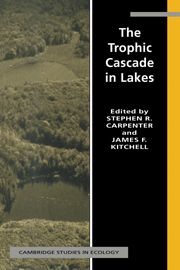Book contents
- Frontmatter
- Contents
- Contributors
- Preface
- 1 Cascading trophic interactions
- 2 Experimental lakes, manipulations and measurements
- 3 Statistical analysis of the ecosystem experiments
- 4 The fish populations
- 5 Fish behavioral and community responses to manipulation
- 6 Roles of fish predation: piscivory and planktivory
- 7 Dynamics of the phantom midge: implications for zooplankton
- 8 Zooplankton community dynamics
- 9 Effects of predators and food supply on diel vertical migration of Daphnia
- 10 Zooplankton biomass and body size
- 11 Phytoplankton community dynamics
- 12 Metalimnetic phytoplankton dynamics
- 13 Primary production and its interactions with nutrients and light transmission
- 14 Heterotrophic microbial processes
- 15 Annual fossil records of food-web manipulation
- 16 Simulation models of the trophic cascade: predictions and evaluations
- 17 Synthesis and new directions
- References
- Index
12 - Metalimnetic phytoplankton dynamics
Published online by Cambridge University Press: 06 August 2010
- Frontmatter
- Contents
- Contributors
- Preface
- 1 Cascading trophic interactions
- 2 Experimental lakes, manipulations and measurements
- 3 Statistical analysis of the ecosystem experiments
- 4 The fish populations
- 5 Fish behavioral and community responses to manipulation
- 6 Roles of fish predation: piscivory and planktivory
- 7 Dynamics of the phantom midge: implications for zooplankton
- 8 Zooplankton community dynamics
- 9 Effects of predators and food supply on diel vertical migration of Daphnia
- 10 Zooplankton biomass and body size
- 11 Phytoplankton community dynamics
- 12 Metalimnetic phytoplankton dynamics
- 13 Primary production and its interactions with nutrients and light transmission
- 14 Heterotrophic microbial processes
- 15 Annual fossil records of food-web manipulation
- 16 Simulation models of the trophic cascade: predictions and evaluations
- 17 Synthesis and new directions
- References
- Index
Summary
Introduction
Temperature, light and oxygen change markedly with depth, thereby altering the habitats of phytoplankton. Often, the upper waters are the most favorable habitat for algae, so maximum algal biomass occurs in the epilimnion. Where there is adequate light penetration to near or below the thermocline, however, the maximum algal biomass may occur deep in the water column. Algal maxima in the metalimnion and hypolimnion are known from many lakes (Moll & Stoermer, 1982). This chapter is especially concerned with metalimnetic communities of algae found near the thermocline. Although metalimnetic algae can attain high biomass and can contribute substantially to whole-lake primary productivity (Moll & Stoermer, 1982), little is known about the mechanisms which control their dynamics.
Epilimnetic phytoplankton communities benefit from relatively favorable light and temperature, but can suffer great losses through sedimentation. In addition, cells are constantly mixed throughout the epilimnion and must cope with changing light conditions (Reynolds, 1984a). Nutrients are depleted as the summer progresses with little opportunity for regeneration from below before fall turnover. Also, migrating zooplankton and zooplankton feces can transport phosphorus into the hypolimnion, further depleting the nutrient pool (Dini et al., 1987). On the other hand, grazing losses may be low for many hours each day if zooplankton migrate in and out of the epilimnion (Lampert & Taylor, 1985; Dorazio et al., 1987; Chapter 9).
In contrast, metalimnetic phytoplankton communities must contend with lower light levels and temperatures, which can reduce growth rates (Healey, 1983; Raven & Geider, 1988; Reynolds, 1984a).
- Type
- Chapter
- Information
- The Trophic Cascade in Lakes , pp. 210 - 224Publisher: Cambridge University PressPrint publication year: 1993
- 6
- Cited by



